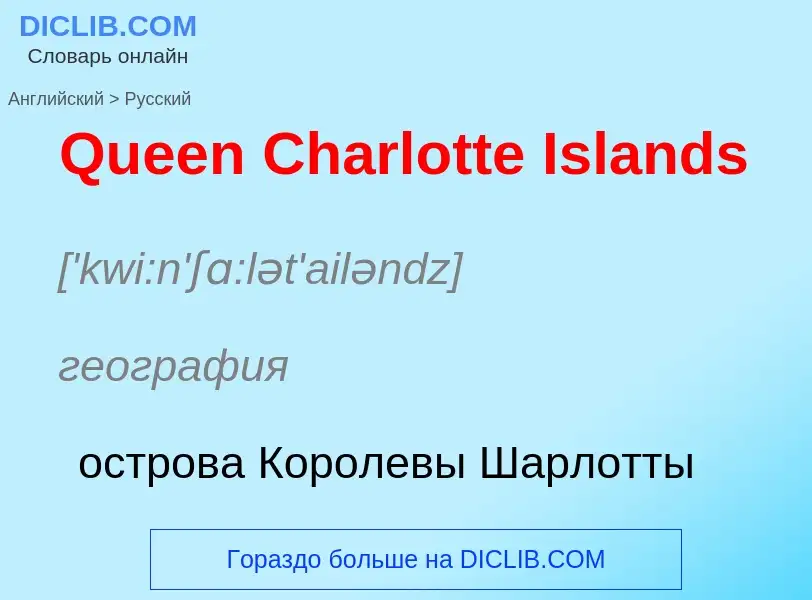Tradução e análise de palavras por inteligência artificial ChatGPT
Nesta página você pode obter uma análise detalhada de uma palavra ou frase, produzida usando a melhor tecnologia de inteligência artificial até o momento:
- como a palavra é usada
- frequência de uso
- é usado com mais frequência na fala oral ou escrita
- opções de tradução de palavras
- exemplos de uso (várias frases com tradução)
- etimologia
Queen Charlotte Islands - tradução para russo
['kwi:n'ʃɑ:lət'ailəndz]
география
острова Королевы Шарлотты
['kwi:n'ʃɑ:lət'saund]
география
залив Королевы Шарлотты
['ʃɑ:lət]
существительное
кулинария
шарлотка
Definição
Wikipédia
.jpg?width=120)
Haida Gwaii (; Haida: X̱aaydag̱a Gwaay.yaay / X̱aayda gwaay, literally "Islands of the Haida people") is an archipelago located between 55–125 km (34–78 mi) off the northern Pacific coast of Canada. The islands are separated from the mainland to the east by the shallow Hecate Strait. Queen Charlotte Sound lies to the south, with Vancouver Island beyond. To the north, the disputed Dixon Entrance separates Haida Gwaii from the Alexander Archipelago in the U.S. state of Alaska.
Haida Gwaii consists of two main islands: Graham Island (Kiis Gwaay) in the north and Moresby Island (T'aawxii X̱aaydaɢ̱a Gwaay.yaay linaɢ̱waay, literally: south people island half, or Gwaay Haanas "Islands of Beauty") in the south, along with approximately 400 smaller islands with a total landmass of 10,180 km2 (3,931 sq mi). Other major islands include Anthony Island (Ḵ'waagaaw / Sɢ̱ang Gwaay), Burnaby Island (Sɢ̱aay Kun Gwaay.yaay), Langara Island (Kiis Gwaay), Lyell Island, Louise Island, Alder Island (Ḵ'uuna Gwaay / Ḵ'uuna Gwaay.yaay), and Kunghit Island. (For a fuller, but still incomplete, list see List of islands of British Columbia.)
Part of the Canadian province of British Columbia, the islands were known from 1787 until 2010 as the Queen Charlotte Islands, and colloquially as "the Charlottes". On June 3, 2010, the Haida Gwaii Reconciliation Act formally renamed the archipelago as part of the Kunst'aa guu – Kunst'aayah Reconciliation Protocol between British Columbia and the Haida people.
The islands form the heartland of the Haida Nation, upon which people have lived for 13,000 years, and who currently make up approximately half of the population. The Haida exercise their sovereignty over the islands through their acting government, the Council of the Haida Nation (CHN, X̱aaydaG̱a Waadlux̱an Naay). As recently as 2015, the Haida Nation hosted First Nations delegations such as the potlatch and subsequent treaty signing between the Haida and Heiltsuk Nation. A small number of Kaigani Haida also live on the traditionally Tlingit Prince of Wales Island in Alaska.
Some of the islands are protected under federal legislation as the Gwaii Haanas National Park Reserve and Haida Heritage Site, which includes the southernmost part of Moresby Island and several adjoining islands and islets. Coastal temperate rain forest at the shore, the preserve also includes the San Cristoval Mountains, so named by the first European explorer, Juan Perez, and the oldest surviving European place name on the BC coast. Facilities are minimal, and access is via boat or seaplane.
Also protected, but under provincial jurisdiction, are several provincial parks, the largest of which is Naikoon Provincial Park on northeastern Graham Island. The islands are home to an abundance of wildlife, including a large subspecies of black bear (Ursus americanus carlottae), and the smallest subspecies of ermine, the Haida ermine (Mustela haidarum haidarum), both endemic to the islands. Black-tailed deer, elk, beaver, muskrat, two species of rats, and raccoon are introduced species of mammals that have become abundant, imparting many ecological changes to the ecosystem.

.jpg?width=200)
![[[Totem pole]] in [[World Museum]], [[Liverpool]] [[Totem pole]] in [[World Museum]], [[Liverpool]]](https://commons.wikimedia.org/wiki/Special:FilePath/Haida House Frontal Pole, Liverpool Museum July 08 2010.jpg?width=200)
![Houses and [[totem poles]], Skidegate, 26 July 1878 ([[George Mercer Dawson]], Geological Survey of Canada, NAC-PA-37756) Houses and [[totem poles]], Skidegate, 26 July 1878 ([[George Mercer Dawson]], Geological Survey of Canada, NAC-PA-37756)](https://commons.wikimedia.org/wiki/Special:FilePath/Haida Houses.jpg?width=200)
![Prince of Wales Island]] is Kaigani Haida territory, but is not included in the term Haida Gwaii. Prince of Wales Island]] is Kaigani Haida territory, but is not included in the term Haida Gwaii.](https://commons.wikimedia.org/wiki/Special:FilePath/NWCoast1a.png?width=200)


![[[Bechtler Museum of Modern Art]] [[Bechtler Museum of Modern Art]]](https://commons.wikimedia.org/wiki/Special:FilePath/BechtlerMuseumCharlotte.jpg?width=200)
![[[Bank of America Corporate Center]] [[Bank of America Corporate Center]]](https://commons.wikimedia.org/wiki/Special:FilePath/BofA Corp Center.jpg?width=200)
![[[Carolinas Medical Center]] is the flagship hospital of [[Atrium Health]] [[Carolinas Medical Center]] is the flagship hospital of [[Atrium Health]]](https://commons.wikimedia.org/wiki/Special:FilePath/Carolinas Medical Center.jpg?width=200)
![[[Charlotte-Douglas International Airport]] with the Uptown Charlotte skyline in the background [[Charlotte-Douglas International Airport]] with the Uptown Charlotte skyline in the background](https://commons.wikimedia.org/wiki/Special:FilePath/Charllotte Douglas International Airport.png?width=200)
![Truist Center, [[Truist Financial]]'s headquarters in Charlotte Truist Center, [[Truist Financial]]'s headquarters in Charlotte](https://commons.wikimedia.org/wiki/Special:FilePath/Charlotte hearst tower.jpg?width=200)
![North Charlotte]] North Charlotte]]](https://commons.wikimedia.org/wiki/Special:FilePath/Davidson at 36th intersection.jpg?width=200)
![[[Discovery Place]] [[Discovery Place]]](https://commons.wikimedia.org/wiki/Special:FilePath/Discovery Place-27527-1.jpg?width=200)
![[[Duke Energy Center]] and [[The Westin Charlotte]] [[Duke Energy Center]] and [[The Westin Charlotte]]](https://commons.wikimedia.org/wiki/Special:FilePath/Duke Energy Center and The Westin Charlotte, 2010.jpg?width=200)

![[[Harvey B. Gantt Center for African-American Arts + Culture]] [[Harvey B. Gantt Center for African-American Arts + Culture]]](https://commons.wikimedia.org/wiki/Special:FilePath/Harvey B. Gantt Center on Opening Day.jpg?width=200)
![[[ImaginOn]] Children's Theater and Library [[ImaginOn]] Children's Theater and Library](https://commons.wikimedia.org/wiki/Special:FilePath/Imaginon.jpg?width=200)
![[[Little Sugar Creek Greenway]] at E 4th Street overpass [[Little Sugar Creek Greenway]] at E 4th Street overpass](https://commons.wikimedia.org/wiki/Special:FilePath/Little Sugar Creek Greenway at 4th Street.jpg?width=200)
![Blue Line's]] Bland Street Station in Charlotte's South End neighborhood Blue Line's]] Bland Street Station in Charlotte's South End neighborhood](https://commons.wikimedia.org/wiki/Special:FilePath/LynxBlandStreet.jpg?width=200)
![[[Mint Museum]] in Uptown Charlotte [[Mint Museum]] in Uptown Charlotte](https://commons.wikimedia.org/wiki/Special:FilePath/Mint Museum in uptown Charlotte, North Carolina.jpg?width=200)

![St. Peter's Catholic Church]], located in Uptown, is the city's oldest Catholic church. St. Peter's Catholic Church]], located in Uptown, is the city's oldest Catholic church.](https://commons.wikimedia.org/wiki/Special:FilePath/Saint Peter Catholic Church (Charlotte, North Carolina) - view from Mint Museum.jpg?width=200)

![[[Truist Field]], home of the [[Charlotte Knights]] [[Truist Field]], home of the [[Charlotte Knights]]](https://commons.wikimedia.org/wiki/Special:FilePath/Truist Field Knights Stadium.jpg?width=200)


